Home
Aussie Bee Online
Welcome
New Articles
About Native Bees
Bee Photo Gallery
Bees in Your Area
Common Questions
Rescuing Native Bees
Exotic Bumblebees
What are Stingless Bees?
Buying Stingless Bees
Honey Production
Crop Pollination
Study Native Bees
Field Guide
Information Booklets
Tim Heard's Book
John Klumpp's Book
Aussie Bee Back Issues
Seminars
Links
Support Native Bees
Aussie Bee Shop
Order Form
Who We Are
Donations
Privacy Policy
Free Newsletter
Website Survey
Download Printer-Friendly PDF version of this article
Aussie Bee's Gardens Rise from the Ashes
Dr Anne Dollin
Australian Native Bee Research Centre
August 2002
A devastating landscape of thick black ash, charred trees and smouldering fires stretched in all directions under a choking blanket of smoke. Only the brick building housing the Aussie Bee headquarters remained unscathed. The bee gardens had been destroyed along with many precious bee nests and the Aussie Bee safari caravan and the bees’ ‘Winter Residence’ greenhouse had burnt to the ground. This was the afternoon of Christmas Day 2001.
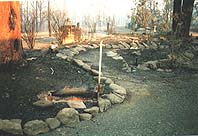 |
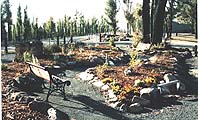 |
Eight months later, with the marvellous help and encouragement of many Aussie Bee supporters, Aussie Bee has risen from the ashes! Shiny new fences surround the property, the blackened shed has been repaired, truckloads of charred debris have been removed, a new caravan is being fitted out for the next safari, and nodding lavender and hebe flowers in a rainbow of colours await the visits of the bees.
The loss of the bee gardens was both a major setback and a special opportunity. Dense, mature shrubs that had fed our bees for over a decade had been reduced to charred sticks. However, now we had the chance to use all our new knowledge about plants loved by native bees to create even better bee gardens!
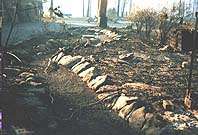 |
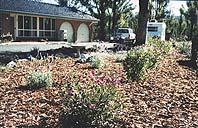 |
Over the years, through our Aussie Bee surveys and the advice and experience of supporters, we have discovered a wonderful diversity of plants that native bees enjoy. These plants would become the foundations of the new bee gardens:
The New Bee Gardens
Plants Loved by Stingless Bees
Abelia x grandiflora
We have found that the original full size Abelia variety attracts native bees much better than the dwarf variety or the golden Abelia.
Brachyscome
These long flowering ground covers are popular with stingless bees.
Grevilleas
Many Grevilleas such as Grevillea Moonlight provide good nectar for bees.
Hebe
The lush blooms of the long flowering hebes strongly attract stingless bees.
Coral Plant
Russelia
The coral plant’s red tubular flowers are great for stingless bees but it spreads quite strongly and can be hard to contain.
Thryptomene saxicola FC Payne
This graceful winter flowering shrub attracts stingless bees and other native bees.
Plants Loved by Blue Banded Bees and Carpenter Bees
Abelia x grandiflora
Blue banded bees and carpenter bees are also regular visitors to the dense flowers of the large Abelia variety.
Butterfly Bush
Buddleja davidii *
Blue banded bees love Buddleja flowers and can often be seen darting from flower to flower.
Lavender
Lavenders are special favourites of the blue banded bees. The French lavender, Lavandula dentata, is a strong shrub with abundant flowers.
Salvia
Many varieties of Salvia attract blue banded bees. Densey Clyne, naturalist and author, says Salvia uliginosa is particularly popular with her bees.
Paraguay Nightshade
Solanum rantonetti
This fast growing plant forms a very large, dense shrub. Its abundant purple flowers attract carpenter bees and blue banded bees. These bees are capable of a special type of pollination called buzz pollination. The bee wraps her body around the flower and buzzes it (by vibrating her muscles) to release the pollen. These flowers offer great opportunities for watching the bees perform this interesting behaviour.
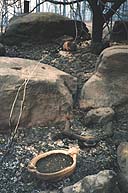 |
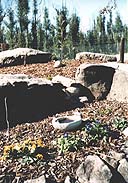 |
Plants Loved by Leafcutter Bees
Butterfly Bush
Buddleja davidii *
Leafcutter bees find the Buddleja’s soft leaves ideal for nesting materials. They leave their characteristic circular cuts in the edges of the leaves and if you are lucky you may see the leafcutter bees’ antics as they cut their tiny leaf pieces (see Aussie Bee Issue 9).
Roses
Leafcutter bees also love clipping rose leaves for nesting materials.
* Note: Buddleja davidii is a particularly good garden plant for native bees. However, it can act as an environmental weed in damp sclerophyll forest, disturbed areas, roadsides and river beds, especially in Victoria and SA. See: Environmental Weeds: a Field Guide for SE Australia, K Blood (2001). We have not had any problem with it in Sydney but take care that it does not cause a weed problem in your area.
Other Good Bee-Friendly Plants
Bottlebrush
Callistemon
These nectar rich flowers also attract native bees.
Christmas Bush
Ceratopetalum gummiferum
‘Alberys Red’
This large shrub, with dense cream flowers in springtime, attracts many native bees.
Daisies
Many varieties such as the African Daisy Dimorphotheca are long flowering, and popular with native bees.
Eucalyptus
Gum blossom is often covered with clouds of native bees.
A Contribution of Plants
Plant enthusiast, Maureen Maguire of Mortdale, NSW, (see Aussie Bee Issue 16) came to our aid with offers of native plants handraised to help replant our bee gardens. One bright sunny morning Maureen drove up with her carload of lovingly raised seedlings and we spent a delightful day together planting them in the gardens. We greatly appreciate Maureen’s contribution!
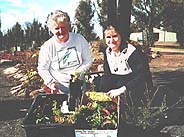 |
Here are some of the plants that Maureen chose and her reasons for including them:
Maureen Maguire’s Selections
Austromyrtus tenuifolia
Maureen has seen small native bees such as the Golden Shouldered Leioproctus visiting these myrtle-like flowers.
Brachyscome angustifolia
According to Native Bees of the Sydney Region – A Field Guide, Brachyscome species are among the ten best plants for attracting native bees. This Brachyscome is native to the lower Blue Mountains.
Brachyscome multifida
Maureen has often seen leafcutters and other small native bees on this species and it flowers for a long period.
Hibbertia dentata
Maureen says the Common Teddy Bear Bee and the Common Blue Banded Bee love buzzing the flowers of Hibbertia scandens. Hibbertia dentata was chosen because its slightly less vigorous growth suited the ANBRC gardens better. Maureen hopes it will also attract the bees.
Lemon Scented Tea Tree
Leptospermum polygalifolium
Leptospermum species are also in the ‘top ten’ list in Native Bees of the Sydney Region – A Field Guide.
Fan Flower
Scaevola humilis
Maureen has seen many small native bees and leafcutters visiting these flowers.
Senna clavigera
Maureen has seen the Common Teddy Bear Bee, the Common Blue Banded Bee and the Emerald Homalictus buzzing the flowers of this bush. Leafcutters also clip pieces of the leaves for their nests. It flowers over a long period.
Coast Rosemary
Westringia fruticosa
Westringia is also in the ‘top ten’ list in Native Bees of the Sydney Region – A Field Guide. Maureen says all bees love this species. It flowers over a long period and is tough and reliable.
Westringia longifolia
Maureen says this is another good Westringia that native bees like.
Other Invaluable Support
Over a hundred Aussie Bee supporters rallied to help us recover from this disaster by sending cash donations. These generous contributions were a tremendous help with the many expenses involved in our repair work and we thank each and every person for their kindness.
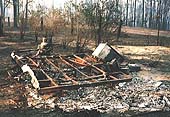 |
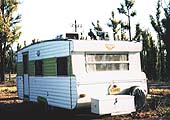 |
A number of beekeepers even offered us replacement hives of stingless bees! The hives that we lost in the bushfire had been a treasured part of our bee gardens for over a decade and we greatly appreciate the generous offers of these beekeepers. As our new bee gardens begin nectar production this summer we look forward to accepting some hives so that the Aussie Bee gardens will be alive once more with the hum of native bees.
Back In Business Again!
In July, with the Aussie Bee grounds at last largely restored, we turned our attention to our publishing work once more. The purpose of the Aussie Bee safari to Queensland in September 2001 had been to collect additional information for our next volume of Tips on Stingless Beekeeping by Australian Beekeepers. As we began to sort through the mass of ideas, photographs and drawings it soon became clear that there would be ample material for two volumes! So now we are proud to release Volumes 2 and 3 of Tips on Stingless Beekeeping by Australian Beekeepers. We hope these new booklets, brimming with new creative ideas and techniques, will help many Australian beekeepers care for their stingless bees. For more details on these new booklets, please visit the special page on Aussie Bee website.
Aussie Bee has risen from the ashes of the great bushfire of Christmas Day 2001! We thank everyone who supported and encouraged us during this difficult time. From our Aussie Bee headquarters with its newly restored grounds we look forward to sharing the delights of Australian native bees with you for many more years to come.
• Download the PDF version of this article.
(If you have not used PDF before, click here.)
• For more interesting Aussie Bee Online articles on native bees, visit the contents
|
Please feel free to print out this article or to email copies of the PDF version to your friends. This article may also be reproduced or hosted on other websites providing it is kept in its full and unaltered form including ANBRC contact details.
|
.Search Aussie Bee Website:
© 1997-2018 Australian Native Bee Research Centre
PO Box 74, North Richmond NSW 2754, Australia